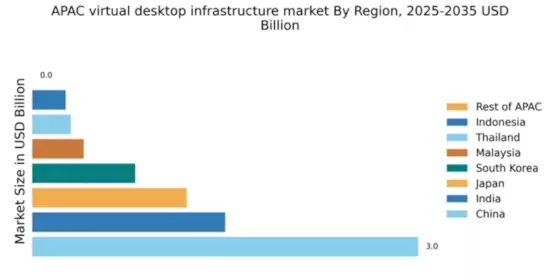China : Strong Growth Driven by Innovation
Key markets include major cities like Beijing, Shanghai, and Shenzhen, where tech hubs are flourishing. The competitive landscape features strong players such as VMware, Microsoft, and Alibaba Cloud, which are actively expanding their offerings. Local dynamics are characterized by a robust startup ecosystem and a growing emphasis on cybersecurity. Industries such as finance, education, and healthcare are increasingly adopting VDI solutions to enhance operational efficiency and data management.
India : Emerging Market with High Potential
Key markets include metropolitan areas such as Bengaluru, Hyderabad, and Mumbai, which are tech innovation hubs. The competitive landscape features major players like Citrix and Microsoft, alongside local startups. The business environment is dynamic, with a focus on IT services and software development. Industries such as IT, education, and healthcare are increasingly leveraging VDI to enhance productivity and reduce costs.
Japan : Tech-Savvy Market with Unique Needs
Key markets include Tokyo and Osaka, where technology adoption is high. The competitive landscape features major players like VMware and IBM, which are well-established in the region. Local market dynamics are influenced by a focus on quality and reliability, with industries such as finance, manufacturing, and healthcare increasingly adopting VDI solutions to streamline operations and enhance security.
South Korea : Strong Demand in Corporate Sector
Key markets include Seoul and Busan, where major corporations are headquartered. The competitive landscape features strong players like Microsoft and Citrix, which are actively expanding their offerings. The business environment is characterized by a focus on innovation and efficiency, with sectors such as manufacturing, finance, and education increasingly adopting VDI to enhance productivity and operational flexibility.
Malaysia : Emerging Market with Opportunities
Key markets include Kuala Lumpur and Penang, where tech startups are emerging. The competitive landscape features players like VMware and local providers. The business environment is evolving, with a focus on enhancing digital infrastructure. Industries such as education, finance, and healthcare are increasingly leveraging VDI to improve service delivery and operational efficiency.
Thailand : Focus on Digital Transformation
Key markets include Bangkok and Chiang Mai, where digital innovation is gaining traction. The competitive landscape features major players like Microsoft and local providers. The business environment is characterized by a focus on enhancing digital capabilities, with sectors such as retail, education, and finance increasingly adopting VDI to improve efficiency and customer engagement.
Indonesia : Growing Market with Unique Challenges
Key markets include Jakarta and Surabaya, where tech innovation is on the rise. The competitive landscape features players like VMware and local startups. The business environment is evolving, with a focus on improving digital infrastructure. Industries such as e-commerce, education, and finance are increasingly adopting VDI to streamline operations and enhance service delivery.
Rest of APAC : Focus on Digital Infrastructure Development
Key markets include various developing countries where digital infrastructure is still in its infancy. The competitive landscape is less defined, with opportunities for both The virtual desktop-infrastructure market. The business environment is characterized by varying levels of technology adoption, with sectors such as education and healthcare poised to benefit from VDI solutions as they seek to modernize operations.


















Leave a Comment